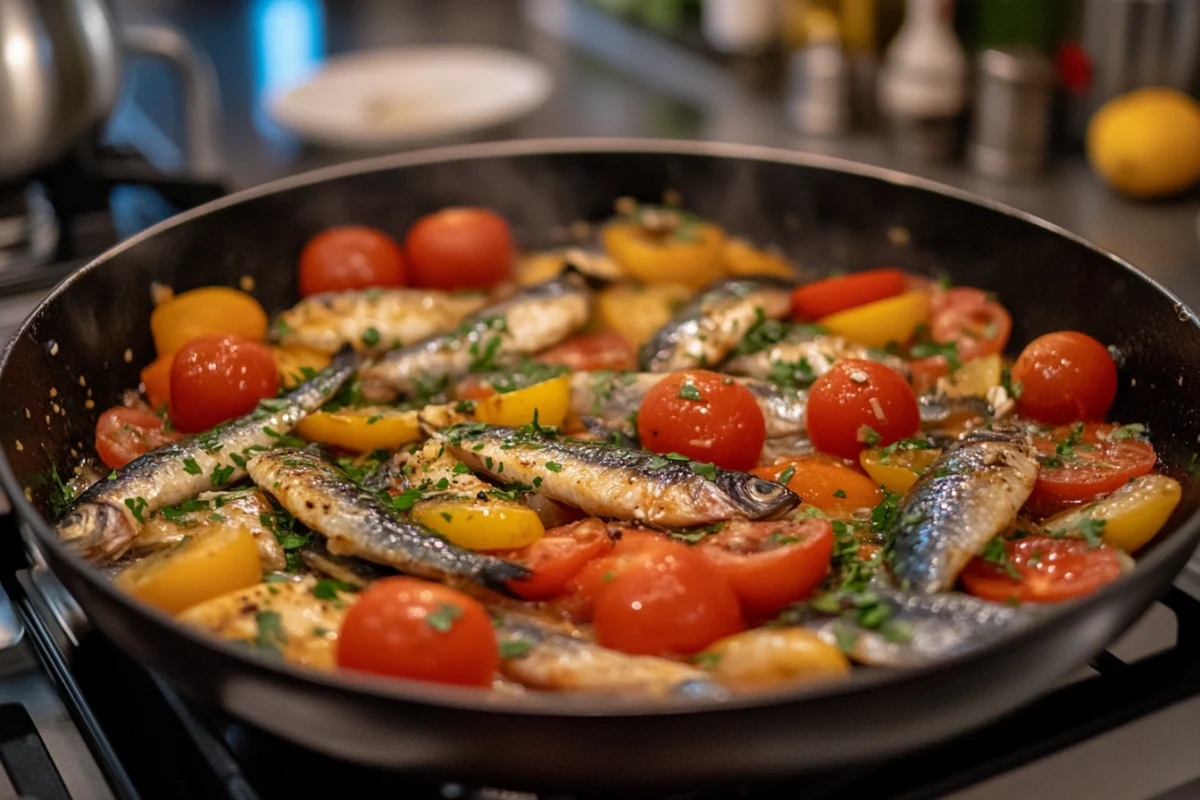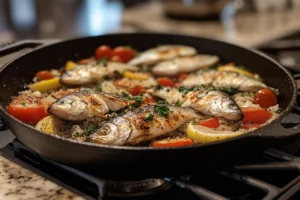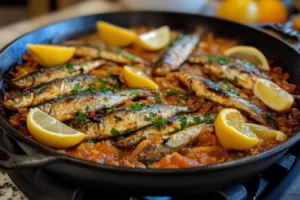Discover the truth behind boquerones and sardines. Learn their origins, flavors, and culinary uses in this comprehensive guide.
Introduction
When navigating the world of seafood, it’s common to encounter questions like, “Are boquerones sardines?” This article delves deep into the distinctions and similarities between these two popular fish, providing clarity for seafood enthusiasts and culinary explorers alike.
If you’re curious about how to prepare them or explore their health benefits, you might want to check out the Boquerones Recipes & Health Benefits article.
Understanding Boquerones and Sardines
What Are Boquerones?
Boquerones are a type of anchovy native to Spain and other Mediterranean regions. They are known for their tender texture and mild flavor, often enjoyed marinated in vinegar. Unlike their salt-cured counterparts, boquerones are fresh and have a lighter taste, making them a favorite in various tapas dishes.
What Are Sardines?
Sardines refer to several species of small, oily fish within the herring family. They are widely consumed globally, appreciated for their rich taste and nutritional benefits. Sardines can be enjoyed fresh, grilled, canned, or smoked, and they are a staple in many culinary traditions due to their versatility and affordability.
Key Differences Between Boquerones and Sardines
Species Classification
Boquerones belong to the anchovy family (Engraulidae), whereas sardines are part of the herring family (Clupeidae). This fundamental difference influences their taste, texture, and culinary uses. While both are small, oily fish, their distinct classifications result in unique culinary experiences.
Flavor Profile
Boquerones offer a milder, less salty flavor compared to the robust and oily taste of sardines. This makes boquerones versatile in various dishes, especially in Mediterranean cuisine. Sardines, on the other hand, have a stronger flavor that holds up well in bold recipes and can stand alone as a flavorful component in meals.
Preparation Methods
Boquerones are typically marinated in vinegar, which tenderizes the fish and enhances their delicate flavor. This preparation method results in a slightly tangy and fresh taste, perfect for appetizers and light dishes. In contrast, sardines are often grilled, canned, or smoked, preserving their natural oils and rich taste. Canned sardines are particularly popular for their convenience and long shelf life.
Texture and Appearance
The texture of boquerones is tender and flaky, making them ideal for delicate dishes. Their appearance after marination is often white or pale pink, earning them the nickname “white anchovies.” Sardines have a firmer and oilier texture, with a silvery sheen and a more robust body structure. This difference in texture makes sardines suitable for heartier preparations.
Culinary Uses of Boquerones and Sardines
Boquerones in Spanish Cuisine
In Spain, boquerones are a staple in tapas. They are commonly served with olive oil, garlic, and parsley, offering a fresh and tangy appetizer. Boquerones are also used in salads, sandwiches, and as toppings for pizzas and bruschetta. Their mild flavor pairs well with a variety of ingredients, allowing for creative culinary applications.
Sardines Around the World
Sardines are versatile and can be found in various culinary traditions. From Italian bruschetta to Japanese sashimi, their adaptability makes them a global favorite. In Mediterranean cuisines, sardines are often grilled with herbs and lemon, while in other regions, they are used in pasta dishes, stews, and even as toppings for pizzas. Canned sardines are a pantry staple, used in salads, spreads, and quick meals.
Fusion and Modern Recipes
Both boquerones and sardines have found their way into modern and fusion cuisines. Chefs experiment with these fish in unexpected ways, incorporating them into gourmet dishes, tapas, and innovative appetizers. The mildness of boquerones complements contemporary flavors, while the boldness of sardines adds depth and richness to modern recipes.
Nutritional Benefits
Health Benefits of Boquerones
Boquerones are a great source of protein, omega-3 fatty acids, and essential vitamins. Their marinated preparation also reduces sodium content, making them a healthier choice compared to other cured fish. Omega-3 fatty acids are crucial for heart health, reducing inflammation, and supporting brain function. Additionally, boquerones provide vitamins such as B12 and D, which are essential for energy metabolism and bone health.
Health Benefits of Sardines
Sardines are packed with nutrients, including vitamin D, calcium, and B vitamins. Their high omega-3 content supports heart health and brain function. Sardines are also an excellent source of calcium, which is vital for maintaining strong bones and teeth. The presence of selenium and vitamin B12 in sardines helps boost the immune system and improve metabolic processes.
Comparing Nutritional Profiles
While both boquerones and sardines offer significant health benefits, sardines generally provide a higher concentration of omega-3 fatty acids and calcium. Boquerones, however, have the advantage of lower sodium content due to their marinated preparation. Including both in a balanced diet can offer a variety of nutrients essential for overall health.
Sustainability and Environmental Impact
Sustainability of Boquerones
Boquerones are generally considered sustainable when sourced responsibly. They play a vital role in marine ecosystems as a food source for larger predators. However, overfishing in certain regions can impact their populations. Sustainable fishing practices and proper management are essential to maintain healthy boquerones stocks and ensure their availability for future generations.
Sustainability of Sardines
Sardines are one of the most sustainable seafood choices due to their abundant populations and rapid reproduction rates. They play a crucial role in marine ecosystems as a food source for larger predators, including whales, dolphins, and seabirds. Sardines’ sustainability is further supported by their lower position in the food chain, which makes them less susceptible to overfishing compared to larger fish species.
Environmental Impact
Both boquerones and sardines have relatively low environmental impacts compared to larger fish species. Their smaller size means they require less energy and resources to produce. Additionally, their role in the marine food web helps maintain ecological balance. Choosing sustainably sourced boquerones and sardines contributes to the preservation of marine biodiversity and the health of ocean ecosystems.
How to Choose and Store Boquerones and Sardines
Selecting Fresh Boquerones
When selecting fresh boquerones, look for clear, shiny eyes and firm flesh. Fresh boquerones should have a pleasant, briny aroma without any overpowering fishy smell. Avoid fish that appear dull or have a strong, unpleasant odor, as these are signs of spoilage. Fresh boquerones should also have vibrant coloring, indicating freshness and quality.
Selecting Fresh Sardines
Choose sardines with bright, metallic skin and clear eyes. Avoid any signs of discoloration or a strong odor, which indicate spoilage. The flesh should be firm to the touch, and the scales should be intact. Fresh sardines should have a clean, ocean-like scent, free from any off-putting smells. When purchasing fresh sardines, ensure they are stored on ice to maintain their freshness until preparation.
Proper Storage Techniques
Store both boquerones and sardines in the refrigerator and consume them within a few days for optimal freshness. To preserve the texture and flavor of fresh boquerones, store them in airtight containers with plenty of ice. You can keep canned sardines in a cool, dry place for a longer shelf life. After opening, refrigerate canned sardines and consume them within a few days. For longer storage, consider freezing fresh sardines, although this may affect their texture.
Tips for Maintaining Freshness
- Refrigeration: Keep both boquerones and sardines refrigerated at temperatures below 40°F (4°C).
- Airtight Containers: Use airtight containers to prevent exposure to air, which can lead to spoilage.
- Ice Bath: For fresh boquerones, storing them on an ice bath can help maintain their freshness.
- Freezing: If freezing sardines, ensure they are properly wrapped to prevent freezer burn and retain their quality.
Recipes Featuring Boquerones and Sardines
Classic Spanish Boquerones
Ingredients:
- Fresh boquerones
- White wine vinegar
- Olive oil
- Garlic cloves, minced
- Fresh parsley, chopped
- Salt to taste
- Lemon wedges
Instructions:
- Clean the boquerones by removing the heads and guts.
- Marinate the cleaned boquerones in white wine vinegar for 2-3 hours.
- Drain the vinegar and pat the fish dry with paper towels.
- Drizzle olive oil over the boquerones and sprinkle with minced garlic, chopped parsley, and salt.
- Let them marinate for an additional hour before serving.
- Serve chilled with lemon wedges and crusty bread.
Grilled Sardines with Lemon and Herbs
Ingredients:
- Fresh sardines, cleaned and scaled
- Olive oil
- Fresh lemon juice
- Fresh herbs (thyme, rosemary, parsley), chopped
- Salt and pepper to taste
- Garlic cloves, minced
Instructions:
- Preheat the grill to medium-high heat.
- In a bowl, mix olive oil, lemon juice, minced garlic, and chopped herbs.
- Brush the sardines with the herb mixture on both sides.
- Season with salt and pepper.
- Grill the sardines for 3-4 minutes on each side until crispy and cooked through.
- Serve immediately with additional lemon wedges and a side of roasted vegetables.
Sardine Pasta Primavera
Ingredients:
- Canned sardines in olive oil
- Spaghetti or your favorite pasta
- Olive oil
- Garlic cloves, minced
- Cherry tomatoes, halved
- Zucchini, sliced
- Bell peppers, sliced
- Fresh basil, chopped
- Red pepper flakes (optional)
- Salt and pepper to taste
- Grated Parmesan cheese
Instructions:
- Cook the pasta according to package instructions until al dente. Drain and set aside.
- In a large skillet, heat olive oil over medium heat.
- Add minced garlic and sauté until fragrant.
- Add cherry tomatoes, zucchini, and bell peppers. Cook until vegetables are tender.
- Add the canned sardines along with their oil. Break them into smaller pieces.
- Season with salt, pepper, and red pepper flakes if desired.
- Toss in the cooked pasta and mix well to combine all ingredients.
- Garnish with fresh basil and grated Parmesan cheese before serving.
Boquerones Salad with Avocado and Citrus
Ingredients:
- Marinated boquerones
- Mixed salad greens
- Avocado, sliced
- Orange segments
- Red onion, thinly sliced
- Olive oil
- Balsamic vinegar
- Salt and pepper to taste
Instructions:
- In a large salad bowl, combine mixed salad greens, avocado slices, orange segments, and red onion.
- Add the marinated boquerones on top.
- Drizzle with olive oil and balsamic vinegar.
- Season with salt and pepper to taste.
- Toss gently to combine all ingredients before serving.
Sardine and Spinach Stuffed Peppers
Ingredients:
- Fresh sardines, cleaned and deboned
- Bell peppers, halved and deseeded
- Fresh spinach, chopped
- Garlic cloves, minced
- Olive oil
- Salt and pepper to taste
- Grated mozzarella cheese
Instructions:
- Preheat the oven to 375°F (190°C).
- In a skillet, heat olive oil and sauté minced garlic until fragrant.
- Add chopped spinach and cook until wilted.
- Add the fresh sardines and cook until they are just done.
- Season with salt and pepper.
- Stuff the bell pepper halves with the sardine and spinach mixture.
- Top with grated mozzarella cheese.
- Place the stuffed peppers on a baking sheet and bake for 20-25 minutes until the peppers are tender and the cheese is melted and bubbly.
- Serve warm as a hearty and nutritious meal.
Frequently Asked Questions (FAQs)
What’s the difference between boquerones and anchovies?
Boquerones, a type of anchovy, typically undergo marination and develop a milder flavor. In contrast, traditional anchovies are cured in salt and have a stronger, saltier taste. People often refer to boquerones as “white anchovies” because their color lightens after marination, distinguishing them from their salt-cured counterparts in both preparation and taste.
Are boquerones sardines?
No, boquerones and sardines belong to different fish families. Boquerones are a type of anchovy (Engraulidae family), while sardines are part of the herring family (Clupeidae). This classification difference results in variations in flavor, texture, and culinary uses between the two.
What do boquerones taste like?
Boquerones have a mild, delicate flavor with a slightly tangy taste from the vinegar marinade, making them less salty than traditional anchovies. Their tender texture and fresh taste make them a versatile ingredient in various dishes, especially in Mediterranean cuisine where they are often served as appetizers or tapas.
Are boquerones white anchovies?
Boquerones are often referred to as white anchovies due to their light color after marination. However, they are distinct from the salt-cured anchovies typically found in stores. The term “white anchovies” emphasizes their milder flavor and tender texture, differentiating them from the more robust and salty traditional anchovies.
Conclusion
In conclusion, while boquerones and sardines may appear similar at first glance, they are distinct in their species classification, flavor profiles, and culinary applications. Boquerones, being a type of anchovy, offer a milder and more delicate taste, making them ideal for light appetizers and fresh dishes. Sardines, with their richer and oilier flavor, are versatile in both traditional and modern recipes, suitable for a wide range of culinary uses from grilling to canning.
Understanding the differences between boquerones and sardines enhances your ability to choose the right fish for your recipes, ensuring a delightful dining experience. Both offer significant nutritional benefits and can be part of a healthy, balanced diet. Additionally, their sustainable sourcing practices make them environmentally friendly choices for conscientious consumers.
Whether you’re savoring the tangy freshness of marinated boquerones or enjoying the robust flavors of grilled sardines, both fish bring unique qualities to the table. Embrace their differences and explore the myriad of ways they can elevate your culinary creations.



